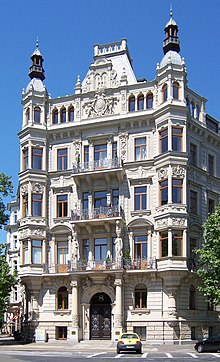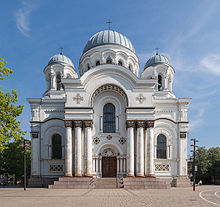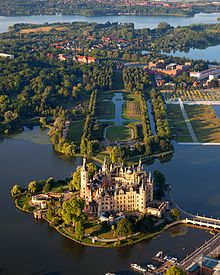Revivalism (architecture)

Revivalism in architecture is the use of visual styles that consciously echo the style of a previous architectural era.
Modern-day revival styles can be summarized within New Classical architecture. Revivalism is not to be confused with complementary architecture, which looks to the previous architectural styles as means of architectural continuity.
Movements
- Mixed

- Gründerzeit – German historicist architecture of the 2nd half of the 19th century, distinctive style mélange; later variations included, e.g., "Heimatstil"
- Russian Revival architecture – generic term for a number of different movements within Russian architecture that arose in second quarter of the 19th century.
- Historicism or Historism – mixed revivals that can include several older styles, combined with new elements
- Neo-Historism – revival of historicist architecture including several revival styles; emerged from Postmodern architecture in the late 1990s
- New Classical Architecture – an umbrella term for modern-day architecture following pre-modernist principles
- Traditionalist School – revival of different regional traditional styles
- Vernacular architecture – umbrella term for regional architecture traditions continuing through the eras, also used and cited in revival architecture
- Indo-Saracenic architecture (revival of Indian architecture and Islamic architecture)
- Georgian Revival architecture (revival of Georgian architecture)
- Mediterranean Revival architecture (revival of Italian Renaissance architecture and Spanish Baroque architecture)
- Preclassical Revival
- Mycenaean Revival architecture (revival of Mycenaean Greek architecture)
- Ancient era Revival
- Egyptian Revival architecture (revival of Ancient Egyptian architecture)
- Indo-Saracenic architecture (revival of Indian architecture and Islamic architecture)
- Neoclassical architecture (revival of Classical architecture)
- Postclassical Revival

- Byzantine Revival architecture (revival of Byzantine architecture)
- Mayan Revival architecture (revival of Maya architecture)
- Medieval Revival
- Romanesque Revival architecture (revival of Romanesque architecture)
- Gothic Revival architecture (revival of Gothic architecture)
- Moorish Revival architecture (revival of Moorish architecture)
- Tudor Revival architecture (revival of Tudor Style architecture)
- Black-and-white Revival architecture

- Renaissance Revival
- Renaissance Revival architecture (revival of Renaissance architecture)
- Italianate architecture
- Palazzo style architecture – revival based on Italian Palazzo
- Mediterranean Revival architecture (revival of Italian Renaissance architecture)
- Palladian Revival architecture (revival of Palladian architecture)
- Châteauesque (revival of French Renaissance architecture)
- Spanish Revival architecture (revival of Spanish Renaissance architecture)
- Jacobethan (revival of Jacobean architecture and Elizabethan architecture)

- Baroque Revival
- Baroque Revival architecture (revival of Baroque architecture)
- Dutch Revival architecture (revival of Dutch Baroque architecture)
- Spanish Revival architecture (revival of Spanish Baroque architecture)
- Edwardian Baroque architecture
- Stalinist baroque
- Queen Anne Revival architecture
- Modern Revival
- Colonial Revival architecture (revival of American Colonial architecture)
- Pueblo Revival Style architecture (revival of Puebloan traditional architecture)
- Cape Cod Revival (revival of Cape Cod)
- Dutch Colonial Revival architecture (revival of Dutch Colonial architecture)
- Spanish Colonial Revival architecture (revival of Spanish Colonial architecture)
- California Churrigueresque (revival of Churrigueresque and Mexican Baroque)
- Mission Revival Style architecture (revival of Architecture of the California Missions)
- Territorial Revival architecture (revival of Territorial architecture)
- Other Revival
- Resort architecture (Bäderarchitektur, includes revival elements and adds new stylistic measures)
- Swiss chalet style
References
- Scott Trafton (2004), Egypt Land: Race and Nineteenth-Century American Egyptomania, Duke University Press, ISBN 0-8223-3362-7. p. 142.
External links
 Media related to Historicist architecture at Wikimedia Commons
Media related to Historicist architecture at Wikimedia Commons
